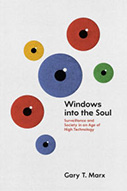Windows Into The Soul: Surveillance And Society In An Age Of High Technology

Author: Gary T. Marx
Publisher: Chicago: University of Chicago Press, 2016. 404p.
Reviewer: Peter Grabosky | March 2017
In 1890, Warren and Brandeis observed the latest developments in still photography and commented “Instantaneous photographs and newspaper enterprise have invaded the sacred precincts of private and domestic life; and numerous mechanical devices threaten to make good the prediction that ‘what is whispered in the closet shall be proclaimed from the house-tops.’” (Warren and Brandeis 1890, 195) Nearly four decades later, Brandeis observed “The progress of science in furnishing the Government with means of espionage is not likely to stop with wire-tapping. Ways may someday be developed by which the Government, without removing papers from secret drawers, can reproduce them in court, and by which it will be enabled to expose to a jury the most intimate occurrences of the home.” (Olmstead v. United States, 277 U.S. 438 (1928) Brandeis, J. dissenting). Fast forward to the 21st Century, and Gary Marx has shown us how these prophecies have become realities. The world has changed unrecognizably since Brandeis’ observations. The pace of technological change is escalating. Technologies not yet foreseeable when Marx began his work are becoming obsolete or replaced by even newer things. These changes have dramatically enhanced the “breadth, depth and integrative potential” of data that are now routinely collected. And then, of course, there are new technologies that are too secret to mention.
The first word that came to mind while reading this book was cornucopia. After decades of research on surveillance, Gary Marx has delivered an abundant harvest indeed. The book is much more than a straightforward treatise. It borders on the encyclopaedic, and is literally overflowing with ideas, observations, and analyses. Windows into the Soul commands the attention of anyone interested in surveillance, past, present, and future.
It is unfortunate that the economics of contemporary academic publishing militate against long books. The book’s printed version runs to 400 pages, including 50 pages of endnotes and some 700 references. In his preface, the author notes that the original manuscript would have reached 1000 printed pages had the publisher not required that it be abridged. The good news is that our age of high technology has allowed for a massive amount of additional illustrative material to be accessible on a special website http://www.press.uchicago.edu/sites/marx/index.html
The book comprises three basic parts: The first six chapters focus on the social scientific aspects of surveillance. They canvass detailed conceptual and theoretical issues, and discuss developments in the goals and organization of surveillance over time. For example, Marx refers to the “softening” of surveillance, whereby it has become more subtle and less obtrusive (but arguably more intrusive). Also addressed are developments in the means of resistance to surveillance.
One’s instinctive reaction to the term “surveillance” is to think in terms of the state. Orwell’s 1984, the recently exposed activities of the US National Security Agency, The East German secret police (“Stasi”), and the pursuit of Martin Luther King by the FBI are but a few examples. However, surveillance is hardly a monopoly of the state. Individuals, citizens’ groups, and private companies all engage in surveillance. Any one of these types may target one or more of the others.
The digital age has brought about the democratization of surveillance. Surveillance today is more than a two-way street: it is, at the very least, a four way intersection. Private citizens, equipped with a mere cell phone, are able to record incidents where excessive force is used by law enforcement agencies against unarmed individuals. Protesters now record video of police behavior during demonstrations. For good or ill, individuals are able to track their children or their elderly parents, or indeed, their spouses. Corporations spy on each other, as do governments. Journalists have hacked into the voicemail of the British royal family. The group Anonymous intercepted a conference call involving the FBI and Scotland Yard, a recording of which has been posted on YouTube.
Major providers of internet services capture vast amounts of personal information, freely offered by their subscribers. Services that appear to be free of charge are in fact provided in return for data. Individuals’ shopping habits, website visits, and a raft of personal information are thus captured and on-sold by the service providers or by information brokers for marketing purposes. As more and more commerce migrates to the online environment, commerce is becoming impossible without the large scale collection of personal data. Ironically, private surveillance entities have fewer constraints and accountability requirements than states themselves, but the vast amounts of information they collect are vulnerable to exploitation by criminals or by state security agencies.
The advent of social media has provided a windfall for attention seekers and exhibitionists. Young people in particular seem ready to bare their souls (and much else) through social media. The nonchalance with which they do so invites the attention not only of voyeurs, but also of law enforcement agencies and prospective employers. Acceptance or rejection of an employment application may depend upon a candidate’s social media persona no less than on face-to-face interviews and letters of recommendation.
Resistance to surveillance can take many forms. Surveillance efforts can be neutralized or undermined, and would-be subjects of surveillance can be extremely adaptable. The use of encryption, steganography, anonymous remailers, and other technologies comprising the architecture of the “Dark Web” are readily accessible, and can impede all but the most intensive and sophisticated methods of surveillance. Distributed denial of service attacks are a common method of protest. More crude but nonetheless imaginative methods of resistance include distorting urine samples (one product for such a purpose is called “Urine Luck”), wearing simple face masks, spray painting the lenses of video cameras, using “Fuzz Buster” radar jammers, and obscuring the numbers of automobile license plates with reflective coatings in order to defeat roadside speed cameras.
The second part (Chapters 7-11) focuses on the cultural aspects of surveillance and asks what symbols and images accompany and define surveillance, and how surveillance is perceived and experienced by both the watched and their watchers. These chapters make use of composite case studies crafted for their maximum descriptive potential. The cases relate to workplace surveillance; parental surveillance of children (“The id in the kid needs a lid”); a voyeur; and surveillance by the “security-industrial complex”– the hybrid system of public sector agencies and private companies that exist symbiotically, and which have become increasingly prevalent. The case studies are sprinkled with satire as insightful and illuminating as it is humorous (Readers with appropriate methodological grounding may wish to consider applying for a grant from the “National Séance Foundation”).
Chapters 12 and 13 address issues of ethics and policy. The fundamental question, whether surveillance is good or bad, is overly simplistic. As the author observes, surveillance can be positively beneficial; the monitoring of an individual’s health data is but one example. On the other hand, its subsequent use for marketing healthcare products may, or may not, be in the public interest. He concludes that surveillance is neither a universal good nor an unmitigated evil. It all depends on who is doing what, to whom, under what circumstances, for what purpose, and with what effect.
Value conflicts and trade-offs are inevitable in surveillance. At what point does it discourage risk taking, innovation, creative self-expression, and other manifestations of nonconformity? How much privacy must we relinquish in order to feel secure? Workplace surveillance may induce stress, disempowerment, and alienation. It may also be necessary in order to protect employees from harassment and bullying, and the organization itself from criminal exploitation by external or internal actors. But abuses of surveillance policy discourse are numerous. By way of illustration, Marx provides no fewer than 44 “technofallacies” of the information age. Awareness of these should be useful, as we enter an era in which “truth” is increasingly invented. So it is that public policy governing surveillance should be evidence-based, not biased as the result of shrill advocacy on the part of vested interests. Given the increasing commercialization of surveillance products and services, competition for market share is intense. One is reminded of the metaphorical query, “how much confidence can you place in a weather report provided by an umbrella salesman?” Moreover, advocates of surveillance are often oblivious to the possibility of downside risk. Marx, whose earlier writing on unintended consequences is echoed in this latest work, reminds us that what seems like a good idea at the time can lead to undesirable outcomes.
The book’s website contains a rich abundance of complementary material. An additional chapter consists of an intellectual autobiography discussing the author’s interest in, and personal experience with, surveillance over the course of his career. Three links take the reader to further discussions of the composite case studies. Two final links provide fascinating material on surveillance in popular music and visual imagery. The former includes reference to Bessie Smith’s 1923 classic “T’Ain’t Nobody’s Business” and to more recent contributions such as “Lyin Eyes,” “Every Breath You Take,” and a variety of contemporary rap lyrics. The link on visual images is a fascinating compendium of materials ranging from cartoons to commercial advertisements to posters, and t-shirts. A still image from Charlie Chaplin’s Modern Times (1936) shows the employer’s face appearing on a wall-sized screen, ordering Charlie back to work after having taken an unauthorised break. Albeit in an employment setting, it anticipates Orwell’s classic novel of a totalitarian dystopia by thirteen years.
Because of its extraordinary breadth, the book should appeal to a wide readership. In addition to those in the burgeoning interdisciplinary field of surveillance studies, it will be of interest to scholars of deviance and social control, cultural studies, criminal justice and criminology. But the book should be read well beyond the towers of academe. The security industry, broadly defined to include private security and intelligence companies as well as state law enforcement and intelligence agencies, would benefit from the book’s insights. So too should it be read by those in the information technology industries, including the manufacturers of the devices and applications which are central to contemporary surveillance, and which are shaping our future.
References
Warren, Samuel and Brandeis, Louis (1890) “The Right to Privacy” Harvard Law Review, 4, 5, 193-220.
Peter Grabosky is Professor Emeritus at the Australian National University


